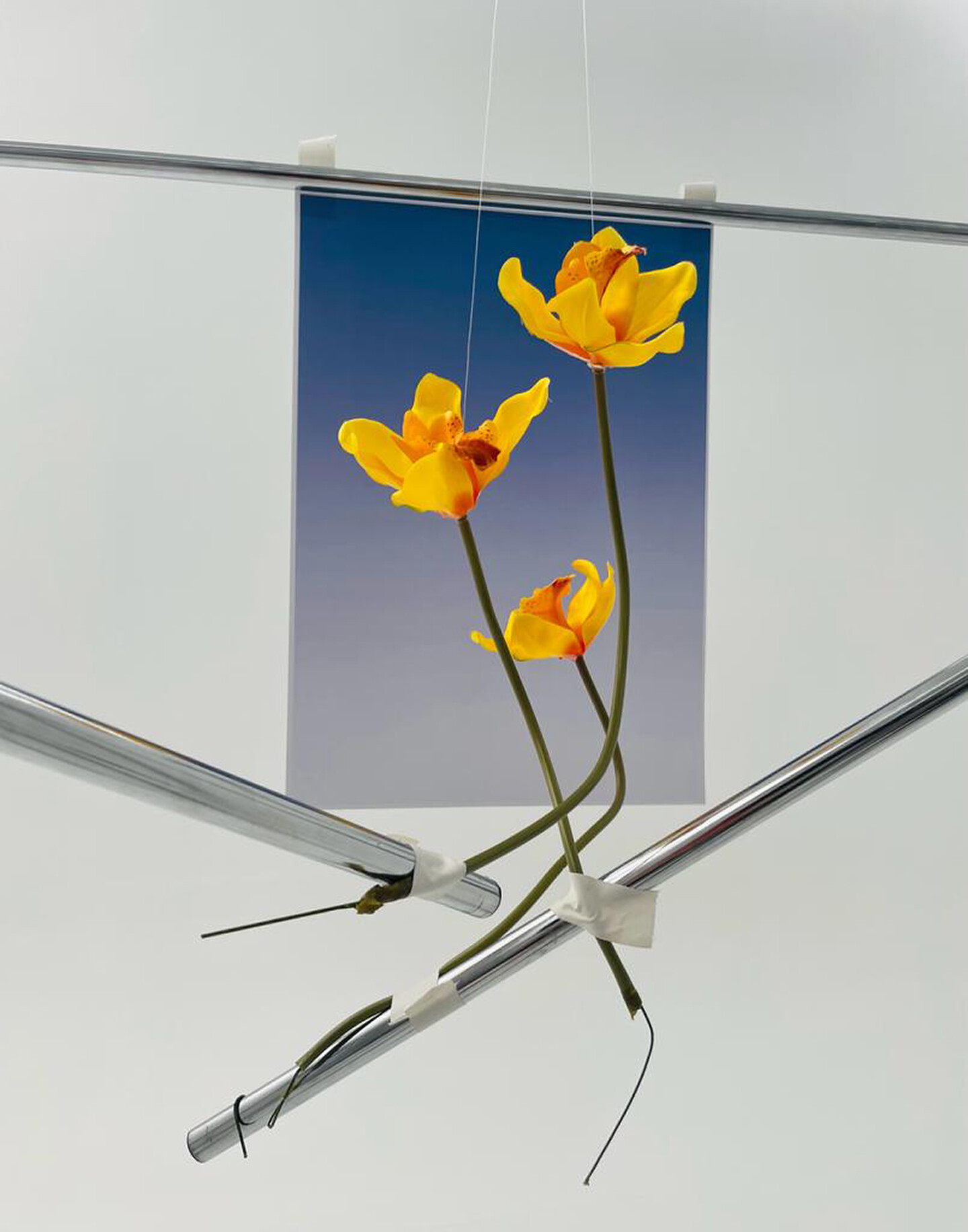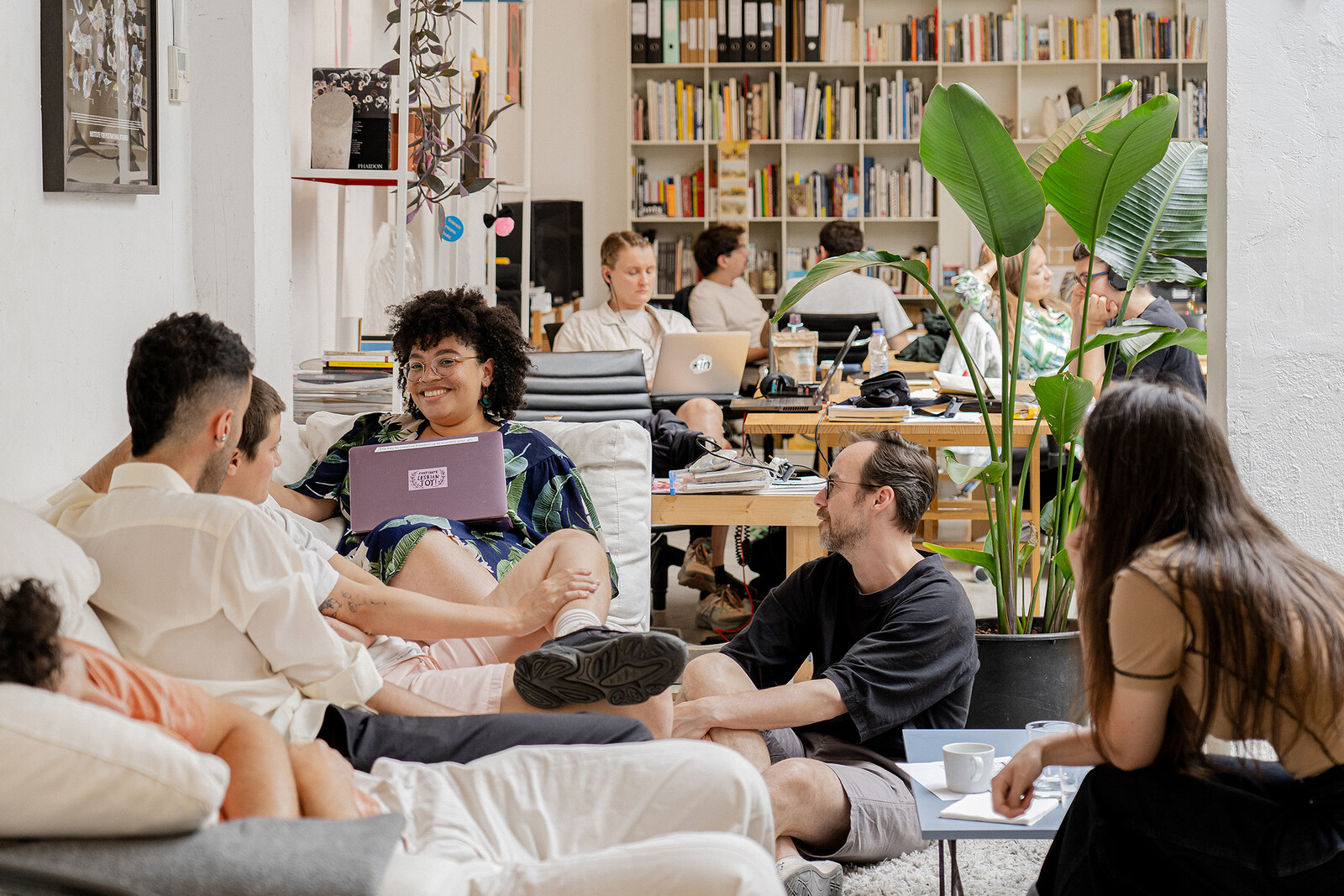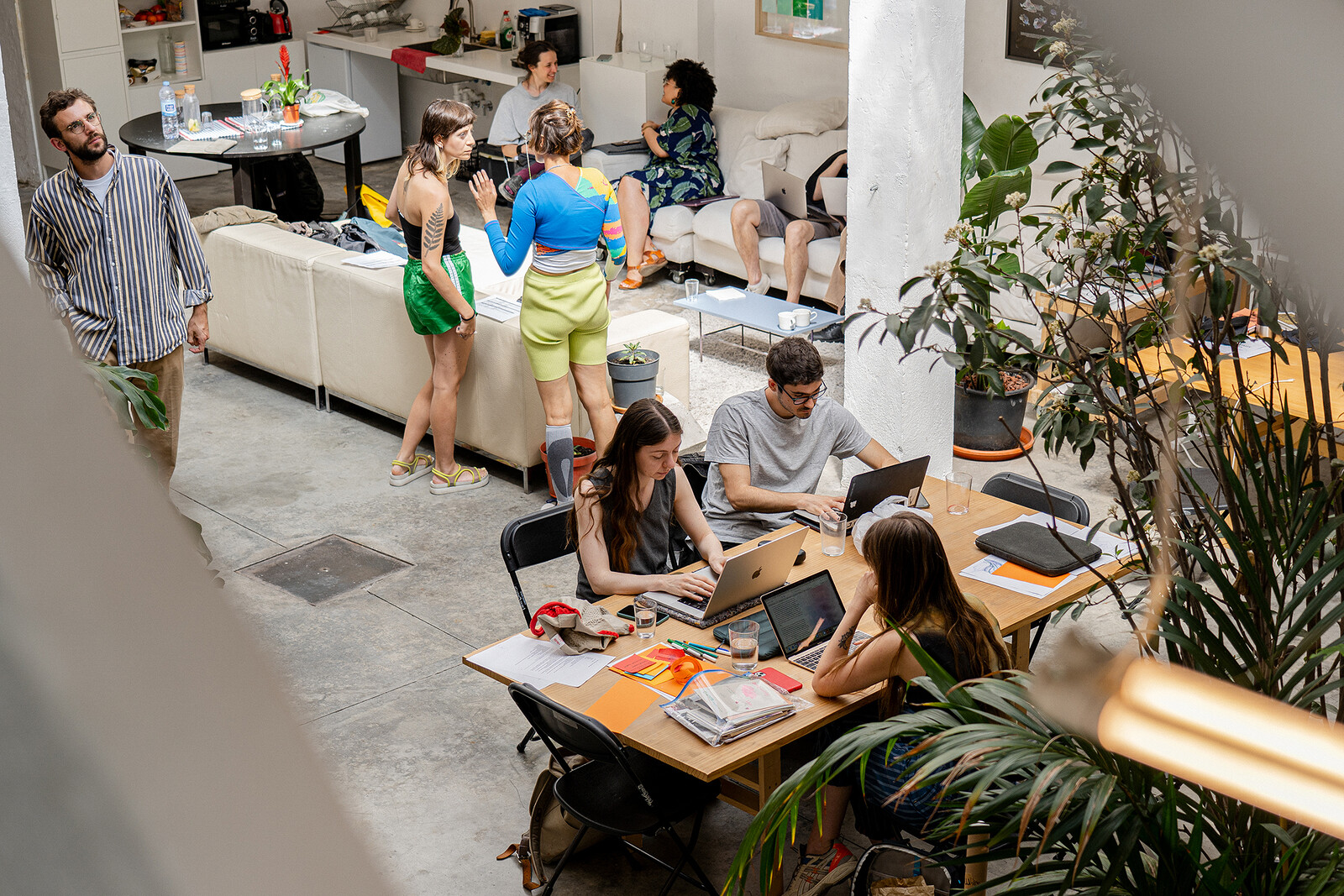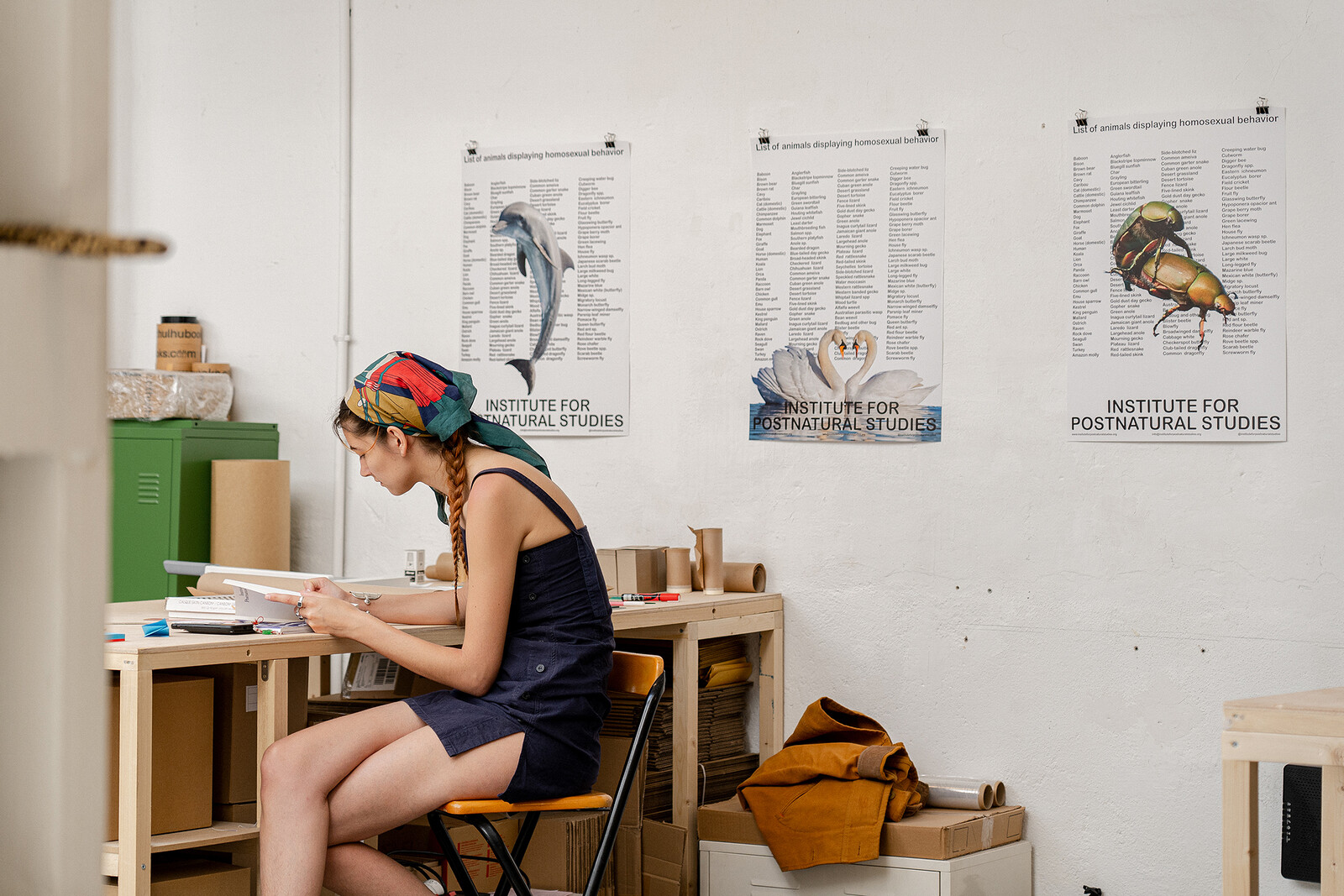End as Beginning
In March 2020, a few days after Spain and a considerable part of the world went into lockdown, the Institute for Postnatural Studies (IPS) began its pedagogical journey with the announcement of its first two seminars: “Postnature and Contemporary Creation” and “After the Future.” In these foundational days, however, entrenched ideas of the “end of the world,” that is, those formed before Covid-19, proliferated in various Spanish contexts as the magnitude of the environmental and civilizational crisis became more evident. At the threshold of the pandemic, the Institute’s first seminars addressed the loss of human centrality, anthropic action, environmental aesthetics, and the displacement of the natural ecosystem, creating an affective space where coronavirus could be considered a generative topic of study. At the time, the polyhedral notion of the “postnatural,” in the Institute’s sense of the term, was defined as a framework for contemporary creation, a political arena, and a subject in conflict. Founded by practitioners from diverse fields of knowledge, including researcher and artist Gabriel Alonso, former INLAND member Karol Muñozcano, architect and designer Pablo Ferreira Navone, artist Yuri Tuma, and designer Matteo Guarnaccia, the Institute for Postnatural Studies could be understood as a para-institution: it acknowledges the tensions and compromises that exist in attempts to operate on the margins and beyond the controlling structures of the hegemonic institutions of art and education. Insofar as the prefix “para-” is political and paradoxical, it refuses the refusal of the institution, allowing for relationships with many of them to take root. Perhaps for this reason, prior to the Zoom boom and the Institute’s first seminars, IPS’s initial activities took place at the Madrid cultural center Círculo de Bellas Artes to accommodate a popular demand for forms of being together, something hard to find in increasingly bureaucratized universities and museums. Other organizations have since partnered with the Institute: Fundación TBA21 | Thyssen-Bornemisza Art Contemporary, Educa Thyssen, CentroCentro, CA2M Centro de Arte Dos de Mayo, and the Spanish Pavilion at the Venice Architecture Biennale. However, the present challenge facing the Institute is to maintain these kinds of collaborations without being subsumed by the phagocytic forces of large structures, which, instead of collaborating, are so often tempted to appropriate the logics and co-opt the momentum of para-institutions that seek to maintain their independence.
In just three years of in-person and online activity, the Institute for Postnatural Studies has dedicated itself to generating spaces and temporalities of reflection on the topic of “postnature” as an artistic and activist framework. This group of practitioners has focused its endeavors on denaturalizing the romantic ideas behind the very definition of “nature,” particularly in relation to the postmodern moment in which various materialities, technologies, and human actions have shattered traditional capacities to comprehend and organize material worlds. Undoubtedly, Covid-19 forced the Institute, along with cultural and scientific communities across the globe, to urgently face this discussion. As Timothy Morton argues, “what we call ‘nature’ is monstrous and mutant, strangely strange to the end.” 1 Echoing this proposition, Alonso said, “If we think about it, the pandemic was the visible, the invisible, the natural, the artificial, the limit, the inside of the outside. It blew up the attempt to recategorize and order ‘nature.’ It is precisely this ambiguous boundary that we call ‘postnature.’” 2 In their view, the environment is neither a resource nor a set of circumstances to which we must adapt but the primary material construct of modernity in which culture and knowledge are produced.
Since its inception, the Institute for Postnatural Studies has curated exhibitions, programmed artistic residencies, and developed research projects while progressively developing seminars, leading to the February 2023 launch of the Postnatural Independent Program (PIP), an independent educational course on the intricate connections between cultural practices, ecological sustainability, epistemology, and the shifting boundaries of wild and artificial life. Based in Madrid, the Institute has undertaken these activities from a position situated in Spain while still recognizing the global reach it has managed to build in the era of Zoom and social media, with a cross-cutting, urgent, and creative approach to deep time, ecological thought, and transnational coexistence. As a producer of metaphysical suffering, the Anthropocene, the era in which the human species has transformed from a biological or social group to a geological force capable of altering the planetary system and its fate, provides the program its theoretical foundation. Thinking-with Eduardo Viveiros de Castro and Déborah Danowski, whose work The Ends of the World was translated into Spanish at the time of the Institute’s first public programs, the course continues to analyze end-of-the-world narratives, understanding them as mythologizing appropriations of the present that tell of the collapse of the distinction between nature and culture. 3 Begun with the pandemic, the end as a beginning has defined the early movements of this para-institutional program.
Of note is the Institute’s concern for the rightward shift in environmental and gender policies, both in Spain and around the world. We should not forget that Spain is at risk of becoming a desert, where water scarcity is a real threat; like climate change, the renewed insurgency of VOX and proto-Francoist right-wing politics in the country threatens the past, present, and future in a nonlinear way: these groups have done their homework in appropriating and hijacking the language of socially engaged practices and studied how attention economies operate. The danger is real and transcends the confines of the peninsula. Youth activism against climate change is a symptom of this urgency, and understanding that we inhabit more-than-human worlds is crucial to alleviating this menace. Negotiating political action and collectivity and defining and redefining the boundaries between self and other—always the underlying lessons at PIP, though ones not always elucidated in “independent” educational programs outside of public institutions—were forcefully intercepted by the pandemic. In this context, Postnatural Independent Program’s collaborations with artist Lorenzo Sandoval is key. Sandoval’s film Aquel Verano del 22 (The Summer of ’22) addresses the ecological degradation of the largest saltwater lagoon in Spain, the Mar Menor, in Murcia, where the coast has undergone a tripartite extractive process of mining, urban development, and intensive agriculture. Through interviews with activists, academics, scientists, and writers, as well as politicians, flamenco musicians, and fisherman from the lagoon, national ecological policies are questioned in the film and subsequently debated the Postnatural Independent Program.
Who is “we”?
Acknowledging the political scenario of Covid-19, ascendant proto-fascism, and the degraded environment, the first edition of the program emerged with the desire to explore the implications of the postnatural as a monstrous and viscous term, a method, and a framework. In the form of an educational program, the Institute sought to speculate on and question not only contemporary ecologies but also new academic approached to radical notions of learning together after the intense digitally mediated experience of the pandemic. Conceived as a six-month research program and aspiring to provide tools for the creation of artistic proposals that have real impact in everyday life across the globe, the Postnatural Independent Program is structured into three theoretical modules that accompany the development of the participants’ practices, with two in-person gatherings in Madrid intended as intensive community-building experiences. The program places less emphasis on the results that might appear in individual artistic contributions and more on the collaborative process of “learning by doing” in each session. So far, only the first in-person meeting has taken place, yet a journey through geopolitics and botanica, ecological awareness, queer worldings and rituals, and perspectivism and non-Western cosmologies guided by Karen Barad, Claire Colebook, and Cary Wolfe—to name a few members of the faculty—has defined the foundations for the shared experiences yet to come. 4
Indeed, end-of-the-world questions, with which the Institute initiated its project, often cast this dilemma as a tabula rasa, that is, as a separation resulting from the collapse of one of the poles of the world–inhabitant duality. Thinking about the future vis-à-vis the world inevitably leads to an in-betweenness, in which separation becomes present and the gap between the inhabitant and the environment is recognized. As Danowski and Viveiros de Castro write,
The end of the world projects backward a beginning of the world; the future fate of humankind transports us to its emergence. The existence of a world before us, although regarded as a philosophical challenge by some […] seems easy enough for the average person to imagine. The possibility of an us before the world, on the other hand, is less familiar to the West’s mythological repertoire. Yet it is a hypothesis explored in several Amerindian cosmogonies. 5
Drawing on this idea and others proposed by Danowski and Viveiros de Castro, the program delved into these complex yet urgent narratives, understanding them as interpolating an “us” in the collapsing distinctions between nature and culture. But, as a necessity, the question of who this “we” comprised quickly emerged, given the context of an online program run from the Spanish capital with twenty participants from across the globe. But if we are to think-with Danowski and Viveiros de Castro, the response is crystal clear: “us,” in the context of the program, means Westerners.
Despite their differences, the program participants asked, How can “we” stay together? How can “we” create collectively while resisting the pull toward homogeneity? To respond to these urgent questions during the first online module “Cartographies of Condensed Presents,” Barad mapped out a constellation of disparate theories and phenomena, including Quantum Field Theory (QFT), galvanism, queer theory, and lightning bolts, as well as the ontological indeterminacy that lies at the core of being. Secondly, Colebook warned participants against the hyperhumanism that lies behind some accounts that are profess to being postnatural or posthuman but regard the human species as a privileged exception in the realm of beings. And, finally, Wolfe reminded participants of something very important: although philosophy cannot capture the radical difference of the more-than-human world, its job is to prepare us for that nevertheless speculative approach, such as the attempt to answer the question “Who are we?” Warm-ups intended to make the emotional bonds built through screens three-dimensional, these online seminars offered a prelude to later in-person crit sessions.
The first in-person gathering in April in Madrid, where the second module “More Than Human Ecologies and Coexistence” was held, offered an opportunity to rehearse an embodied answer to these speculative questions on being. The Institute building provided a gathering place for the six days the group spent together, a base camp where nonvirtual familiarity took shape. From breathing meditations to chicken dancing, each day a different participant in the program proposed an activity that gave rise to a sort of living organism that moved through the city choreographically. With the help of Filipa Ramos and within the framework of the Phonocene, participants explored how active listening allows access to new ways of inhabiting territory and creating new modes of care and kinship in more-than-human worlds. 6 The first group outing was to the Madrid Zoo Aquarium, a session that was preceded by a preparatory meditative assembly, given the debate the visit provoked and the rejection it unleashed. Challenging issues, situations, and images were discussed beforehand online in an attempt to establish a memorandum of understanding; confronting the violence that animals have endured in different sites offered the group a common sensibility and embodied critical thinking. Through encounters with veterinarians and other wildlife professionals, participants questioned the logics and ethics of such sites and the possibility of coexisting with places like zoos. What emerged from these experiences was a reiteration that the actions and affects around the zoo speak more to human worlds than to nonhuman worlds, that is, how care is categorized, interpreted, and perceived through human perspectives. Despite the assumptions and contradictions that the proposal entailed, the Institute explained how Ramos succeeded in generating a complex space that contributed to the construction of a “we” by staying with the trouble of facing the architectural confinement of animals in unnatural, stressful, boring, and yet loaded institutional sites: “This theme or this space seems to have inspired a collective movement within the group, because now, suddenly, there is a seed that has been planted,” said Yuri Tuma. “What would a hologram zoo or a technological zoo look like? What would such a thing mean in a speculative world? All of a sudden, people are coming together, wanting to think about their practice from that fictional space driven by this one gathering.” 7
The accompanying visit to the Casa de Fieras, the site where Madrid’s first zoo was established in 1770, undoubtedly surfaced certain Western epistemes anchored in the Enlightenment and, consequently, the possibility for other kinds of gazes. “In the West’s mythophilosophical tradition,” write Danowski and Viveiros de Castro, “we tend to conceive animality and nature in general as referring essentially to the past.” 8 Nevertheless, the other modules advanced a different understanding of time and offered a valuable embodied experience. In “More than Human Ecologies and Coexistence,” the Institute for Queer Ecology’s drag performance privileged collaboration over individual practices. Like the construction of the “we,” drag, as a form of mimicry, the Institute for Queer Ecology articulated, “is less about disappearing into the background than it is an exercise of flamboyance: like the orchid mantis, they have become more colorful and more attractive than the thing they are mimicking.” The “Final Presentations,” an in-person gathering that will take place in July in the cultural center Matadero (literally, “slaughterhouse”) will allow these questions to be spatially and critically developed by the group practitioners under the guidance of Lorenzo Sandoval. These final presentations will take place in a parasitic way within the framework of the exhibition Clima Fitness, curated by Maite Borjabad and including works by Faysal Altunbozar, Itziar Barrio, Ibiye Camp, Irati Inoriza, and Mary Maggic. 9 As a result of this experience, a possible “we” is ourselves transformed into mantis orchids, into beings that make hypervisible the contradictions, mimicry, and adaptability that surround us. All in all, the construction of a “we” involves the desire and intimacy of the self with its environment, and in its attempt to be connected, it is ecological.


Photoshoot for Postnatural Independent Program 2024. Photo: Daniel Jordan Pompa.
Sensing the Brown
These moments together in Madrid were full of intimate conversations; collective rituals; exercises on new materialities, metabolisms, and desires for future worlds; bodily experiments; and guided meditations proposed and mediated by the participants. Through these activities, the Institute manifested its intent to expose the group to a wide range of media and approaches while sharing a politicized framework for art production. The organizers told of how they experienced intimacy through a process of becoming-chicken, meditating, healing, shaking, moving, and bonding. These kinds of nonbinary logics and embodiments are pedagogical tools for breaking the social constructs and taboos of coexistence that come with inhabiting human cultures, such as the “natural” order of things—traditional ways of addressing the natural, the artificial, the inside, the outside, or, what constitutes Western geographical and epistemological limits. No exams, no evaluations, simply shared and situated knowledge with specialized pastoral mentorship. Beyond this ethos, knowledge production as it regards methodology, validity, and scope is supported not only by the exhibitionary proposal at Matadero but also by the collective editing exercise that the participants of the program have undertaken to produce a publication on new materialities, performativity, territory, and the Phonocene and ecologies of listening, among other topics. The publication emphasizes the transdisciplinary nature of the participants’ practices, in which visual arts are in close dialogue with literature and music, and transcribes many of the sessions of the course. The participants have developed thirty-two research projects that revolve around sculptural and visual practices, writing processes, identity politics, moving images, and dramaturgy, all of which will be featured in this forthcoming ambitious book.
The pilot program has not yet ended, but its progress points to the conclusion of a cycle that challenges traditional educational programming. Considering the distance that separates the program from the universities that would otherwise host it, one critical question remains to be addressed, in the same way the zoo as site was debated: How can we create a bridge between academic institutions and these schools or other “independent” programs that have recently emerged in various geographies without succumbing to the neoliberal privatization of teaching nor contributing to the redefinition of public “interdependent” pedagogies? Within para-institutional logics, I would like to imagine that a reciprocal relationship with knowledge architectures such as the university is possible. We must not forget that these spaces are made by people, and people themselves exert effort within institutions that make structural change imaginable.
Ultimately, what PIP provokes with its positioning, questioning, and hybrid methods is an enactment of modes of border dwelling, rehearsing something akin to what José Esteban Muñoz called a “sense of brown.” This notion aligns with the forms of mimicry that the Institute of Queer Ecology provided, in reading Muñoz’s work, “about the moment of contact, and the encounter and all that it can generate. Brownness is about contact and is nothing like continuousness. Brownness is a being with, being alongside.” 10 Muñoz insists that shared brownness is not knowable in advance and is not reducible to one object or thing. In his view, sensing the brown entails the endeavor of knowing that “the commons of brownness is not identifiable as any particular thing we have in common.” 11 In this sense, perhaps the task of apprehending from difference and the trouble is what finally defines, in this first edition of the program, a possible instituting “we” yet to come. A “we” that challenges the ways of dwelling on the borders that the pandemic made fiercely visible and that forced us to redraw our forms of pedagogical exchange. A “we” that tests the ways in which inhabiting borders contributes to delineating other epistemic frameworks of sensing the common knowledge beyond the skin. A “we” that rehearses the ways in which inhabiting the border constructs new politics of the imagination and a future in which post-democratic institutions are made from below. A “we” that finally comprehends that nature and culture are inextricably bound.
Timothy Morton, The Ecological Thought (Cambridge, MA: Harvard University Press, 2012), cited in Institute for Postnatural Studies, “From Flesh to Data: Non-human Intelligence and Artificial Stupidity,” 2023, →.
Zoom conversation with Gabriel Alonso and Yuri Tuma, May 24, 2023.
See Déborah Dankowski and Eduardo Viveiros de Castro, The Ends of the World, trans. Rodrigo Nunes (Cambridge, UK: Polity, 2016).
The full faculty includes Báyò Akómoláfé, Stacy Alaimo, Karen Barad, Claire Colebrook, Paloma Contreras, Uriel Fogué, Institute of Queer Ecology, Mary Maggic, Filipa Ramos, Lorenzo Sandoval, Gesyada Siregar, and Cary Wolfe.
Deborah Danowski and Eduardo Viveiros de Castro, “Is There Any World to Come?”, e-flux journal 65 (May 2015), →.
Donna Haraway and Vinciane Despret describe the Phonocene as a possible era of sound. See Donna Haraway and Vinciane Despret, “Phonocene,” CCCB: Centre de Cultura Contemporània de Barcelona, October 13, 2020, →.
Zoom conversation with Gabriel Alonso and Yuri Tuma, May 24, 2023.
Danowski and Viveiros de Castro, “Is There Any World to Come?”.
“Clima fitness” is a biological term that defines the capacity of a species to adapt to the environment and refers to the mental and physical preparation necessary to face the consequences of an environmental collapse.
José Esteban Muñoz, “Towards a Definition of the Brown Commons,” Literary Hub, October 23, 2020, →; published in Spanish as “El común marrón,” Concreta 15 (Spring 2020): 54–63.
Ibid.












